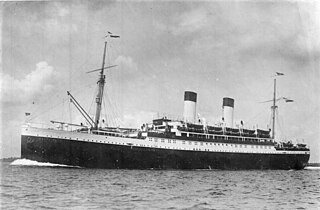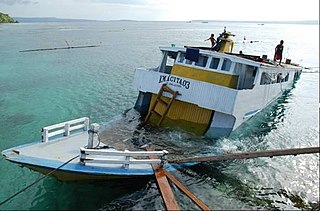
MS Herald of Free Enterprise was a roll-on/roll-off (RORO) ferry which capsized moments after leaving the Belgian port of Zeebrugge on the night of 6 March 1987, killing 193 passengers and crew.

Capsizing or keeling over occurs when a boat or ship is rolled on its side or further by wave action, instability or wind force beyond the angle of positive static stability or it is upside down in the water. The act of recovering a vessel from a capsize is called righting. Capsize may result from broaching, knockdown, loss of stability due to cargo shifting or flooding, or in high speed boats, from turning too fast.
MV Princess Victoria was one of the earliest roll-on/roll-off ferries. Completed in 1947, she operated from Stranraer, Scotland, to Larne, Northern Ireland, initially by the LMS until 1 January 1948 and thereafter by LMS's successor British Railways. During a severe European windstorm on 31 January 1953, she sank in the North Channel with the loss of 135 lives. This was then the deadliest maritime disaster in United Kingdom waters since World War II. For many years it was believed that 133 people had lost their lives in the disaster. However, research by a local historian, Liam Kelly, identified two other victims—Gordon Wright and Thomas Saunders—who had not been identified as there had been no passenger list at the time.

The MS al-Salam Boccaccio 98 was an Egyptian Ro/Ro passenger ferry, operated by El Salam Maritime Transport, that sank on 3 February 2006 in the Red Sea en route from Duba, Saudi Arabia, to Safaga in southern Egypt.

The sinking of MV Teratai Prima occurred on 11 January 2009, around 04:00 local time when a ferry carrying more than 300 people capsized in the Makassar Strait off West Sulawesi, Survivors stated that the ferry had been slammed by 4-metre (13 ft) waves twice. The first one hit so hard that the ship became unbalanced, before another wave hit from a different direction and sank the vessel.

MV Monte Cervantes was a 500 ft (150 m) German passenger liner that cruised the South American route from Buenos Aires to Puerto Madryn (Chubut) to Punta Arenas to Ushuaia and return to Buenos Aires. The ship sailed under German registration and belonged to the South American Hamburg Company. After only two years of service she sank at the beginning of 1930 near Tierra del Fuego. The ship became known as "The Titanic of the South."

The sinking of MV Dumai Express 10 occurred on the morning of 22 November 2009 when a ferry carrying more than 300 people sank near the island of Iyu Kecil in Karimun Regency, Riau Islands during bad weather. Eyewitnesses reported that massive waves had struck the ferry repeatedly, causing the starboard side of the ship to crack. Subsequently, a considerable amount of water poured into the deck. By 9:55 a.m. the ferry was fully submerged.

The ferry MV Sewol sank on the morning of April 16, 2014, en route from Incheon towards Jeju in South Korea. The 6,825-ton vessel sent a distress signal from about 2.7 kilometres north of Byeongpungdo at 08:58 KST. Out of 476 passengers and crew, 306 died in the disaster, including around 250 students from Danwon High School in Ansan City. Of the approximately 172 survivors, more than half were rescued by fishing boats and other commercial vessels that arrived at the scene approximately 40 minutes before the Korea Coast Guard (KCG).

KMP Tampomas II was a roll on-roll off car and passenger ferry owned by the Indonesian shipping company Pelni that burned and sank in the Java Sea while sailing from Jakarta to Ujung Pandang, South Sulawesi on 27 January 1981. This disaster resulted in the deaths of hundreds of passengers.
Events from the year 2011 in Indonesia
MV Sinar Bangun sank on 18 June 2018 in Lake Toba, North Sumatra, Indonesia, during its trip from Simanindo Harbour in Samosir Island to Tiga Ras Harbour in Simalungun Regency. The ferry was carrying 188 passengers and crew. After the sinking, authorities immediately deployed search and rescue personnel to the area. Twenty-one survivors were rescued, three bodies were found and 164 people were listed as missing and presumed dead.

The sinking of MV Marina Baru 2B occurred just after noon on 19 December 2015. The high speed vessel carrying 112 passengers and crew sank off the coast of Bone, South Sulawesi in inclement weather conditions. A nine-day search and rescue operation, conducted by authorities, successfully rescued 45 survivors and recovered 65 bodies from the sea. Twelve people were declared missing and presumed dead.

MV Lestari Maju was a modified 749 tonnes cargo ship that operated domestic passenger service from Bulukumba Regency to Selayar Islands in South Sulawesi. At noon on 3 July 2018, the ship was deliberately grounded off the Selayar Islands. The ferry had reportedly suffered a leak on the port side of the lower deck. As the ferry began to sink, the captain decided to ground the ferry to stop the sinking and ease the rescue effort. The incident killed 35 people; 155 people survived the accident.

The sinking of MV Wahai Star occurred on the night of 10 July 2007, when a speedboat tugged by the ferry accidentally crashed into its stern, resulting in a major leak. In the following days, rescuers managed to save 43 people, while 16 bodies were recovered in the nearby waters.

The sinking of MV Acita 03 occurred on the night of 18 October 2007 when a ferry carrying 174 passengers and crews accidentally capsized during its docking in Baubau, Southeast Sulawesi. 134 passengers and crews survived the disaster while 30 passengers and 1 crew member lost their lives. 9 people were listed as missing and presumed dead.
MV Nusa Kenari 02 was an Indonesian passenger boat which sank off Alor on 15 June 2019. At least three people was killed due to the sinking, with four further missing out of the 52 passengers and crew aboard the vessel.

The Zahro Express disaster occurred on the morning of 1 January 2017 when an Indonesian-flagged wooden passenger vessel caught fire in the waters of Thousands Islands Regency, off the coast of Jakarta. She was travelling from Jakarta's Muara Angke to Tidung Island, a popular tourist destination. The ferry, named MV Zahro Express, was carrying 216 passengers and 5 crew members. Of the 221 passengers and crews, a total of 24 people on board lost their lives.

MV Laut Teduh II was an Indonesian-flagged double-ended RO/RO passenger ferry that served the route from the Port of Merak in Java to the Port of Bakauheni in Sumatra, one of the busiest ferry routes in Indonesia. She was built in 1988 in England and was registered as Laut Teduh II in 2007.

The MS Estonia sank on Wednesday, 28 September 1994, between about 00:50 and 01:50 (UTC+2) as the ship was crossing the Baltic Sea, en route from Tallinn, Estonia, to Stockholm, Sweden. The sinking was one of the worst maritime disasters of the 20th century. It is one of the deadliest peacetime sinkings of a European ship, after the Titanic in 1912 and the Empress of Ireland in 1914, and the deadliest peacetime shipwreck to have occurred in European waters, with 852 lives stated at the time as officially lost.
MV Vipya was a motor vessel used as a passenger-cargo ship that sailed on Lake Malawi in Southern Africa from 1944 to 1946. The ferry had a tonnage of 470 tons, was 140 feet (43 m) in length, 27 feet (8.2 m) in breadth, and had a twin crew. Equipped with a motor engine, it could travel up to a speed of 12 knots. It was built to carry 315 passengers and 100 tons of cargo. On July 30, 1946, the ship set sail with 194 passengers on board. It was caught up in a storm near Chilumba in Karonga where it capsized and sank. The disaster resulted in 145 passengers and crew on board drowning. No remains of the bodies have been recovered. The sternwheel ferry disaster is the worst shipwreck in Malawi's history.

















